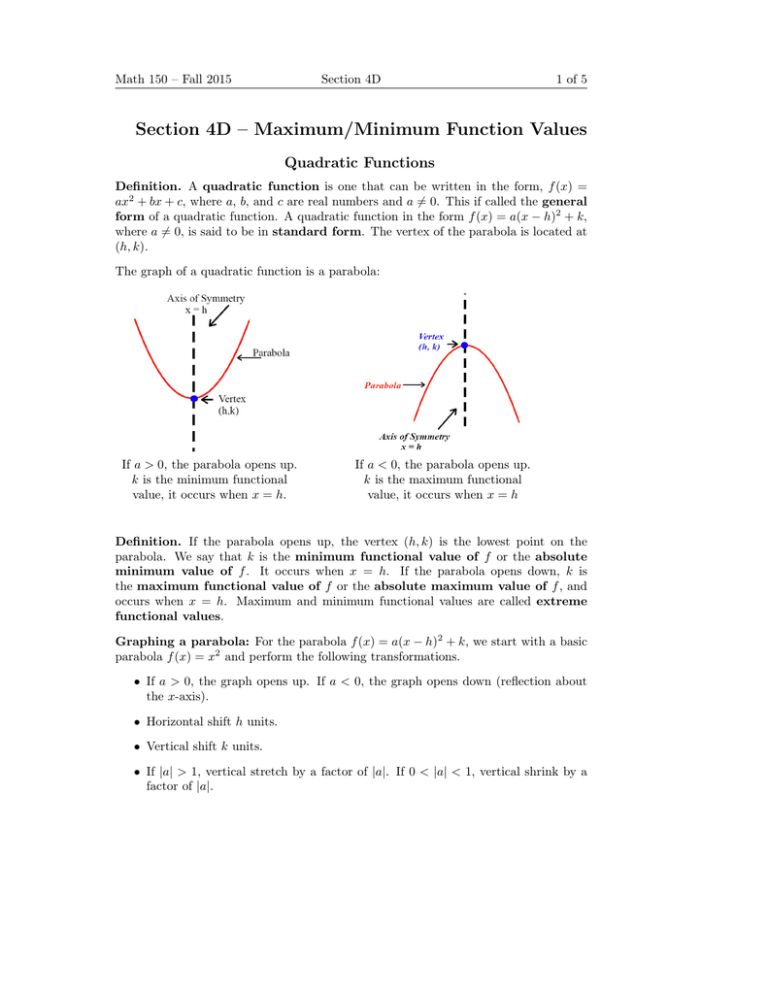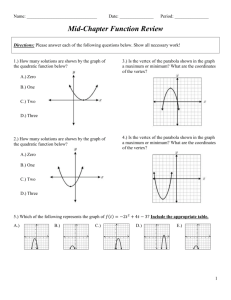Section 4D – Maximum/Minimum Function Values Quadratic Functions
advertisement

Math 150 – Fall 2015 Section 4D 1 of 5 Section 4D – Maximum/Minimum Function Values Quadratic Functions Definition. A quadratic function is one that can be written in the form, f (x) = ax2 + bx + c, where a, b, and c are real numbers and a 6= 0. This if called the general form of a quadratic function. A quadratic function in the form f (x) = a(x − h)2 + k, where a 6= 0, is said to be in standard form. The vertex of the parabola is located at (h, k). The graph of a quadratic function is a parabola: If a > 0, the parabola opens up. k is the minimum functional value, it occurs when x = h. If a < 0, the parabola opens up. k is the maximum functional value, it occurs when x = h Definition. If the parabola opens up, the vertex (h, k) is the lowest point on the parabola. We say that k is the minimum functional value of f or the absolute minimum value of f . It occurs when x = h. If the parabola opens down, k is the maximum functional value of f or the absolute maximum value of f , and occurs when x = h. Maximum and minimum functional values are called extreme functional values. Graphing a parabola: For the parabola f (x) = a(x − h)2 + k, we start with a basic parabola f (x) = x2 and perform the following transformations. • If a > 0, the graph opens up. If a < 0, the graph opens down (reflection about the x-axis). • Horizontal shift h units. • Vertical shift k units. • If |a| > 1, vertical stretch by a factor of |a|. If 0 < |a| < 1, vertical shrink by a factor of |a|. Math 150 – Fall 2015 Section 4D 2 of 5 Converting quadratics from general from to standard form Example 1. Write f (x) = x2 − 7x + 11 in standard form and graph it. Vertex: Domain: Increasing: Axis of Symmetry: Range: Decreasing: Does f have an absolute maximum or minimum value? absolute value of f : occurs at x = Example 2. Write f (x) = −3x2 − 4x − 5 in standard form and graph it. Vertex: Domain: Increasing: Axis of Symmetry: Range: Decreasing: Does f have an absolute maximum or minimum value? absolute value of f : occurs at x = Theorem. The vertex of the parabola f (x) = ax2 + bx + c is located at x = −b 2a . Example 3. Find the maximum or minimum functional value of f (x) = −2x2 +16x−7. At what x value does this minimum or maximum function value occur? Math 150 – Fall 2015 Section 4D 3 of 5 Axis of Symmetry Theorem. For a quadratic function f (x) = ax2 + bx + c, the vertical line x = axis of symmetry. −b 2x is an Example 4. Let f (x) = 2x2 + 7x − 4. Find the axis of symmetry and the coordinates of the vertex. Example 5. If f (1) = 7 and f (−4) = 7, and f (x) is a quadratic function, what is the axis of symmetry? Zeros of Quadratic Functions Definition. The zeros of a function are the x values that make the function value 0, i.e., the x-intercepts of the function. To find the zeros of f (x) set f (x) = 0 and solve. Finding zeros of quadratic funtions: Finding the zeros of a quadratic function is the same as solving a quadratic equation. We had three methods to do this: 1. Factor 2. Complete the Square 3. Quadratic Formula Example 6. Does the function f (x) = 3x2 −2x+4 have any zeros in the real numbers? If so, what are they? Math 150 – Fall 2015 Section 4D 4 of 5 Theorem. The expression b2 − 4ac is called the discriminant of the function f (x) = ax2 + bx + c. The discriminant is the inside of the radcial in the quadratic formula √ −b ± b2 − 4ac x= . 2a Using the discriminant, we have • If b2 − 4ac > 0, then f (x) has two zeros. • If b2 − 4ac = 0, then f (x) has one zero. • If b2 − 4ac < 0, then f (x) has no zeros in the real numbers. Applications We often want to maximize or minimize the value of a function f . If the function f is a quadratic, then the absolute maximum (if f opens down) or absolute minimum (if f opens up) is the y-value of the vertex. Finding max/min: There are two ways to find the absolute maximum/minimum value for f (x) = ax2 + bx + c: • Put the quadratic in standard form f (x) = a(x − h)2 + k, and the absolute maximum/minimum value is k and it occurs at x = h. • Use the formula: the absolute maximum/minimum occurs when x = value is f ( −b 2a ). −b 2a and its If a > 0, then the parabola opens up, and it is a minimum functional value of f . If a < 0, then the parabola opens down, and it is a minimum functional value of f . Example 7. A baseball is thrown upward at a velocity of 72 ft/sec. If it is released at a point 6 feet from the ground, its distance s in feet from the ground at t seconds is given by s(t) = −16t2 + 72t + 6. When will the baseball reach its maximum height and how high will it go? Example 8. What is the smallest product of two numbers if their difference is 10? Math 150 – Fall 2015 Section 4D 5 of 5 Example 9. A farmer wishes to fence a rectangular area of his farm to hold his cows and sheep. He also wants to keep the cows and sheep separate, so he wants to run a fence down the middle to create two equally sized rectangular areas. If he has a total of 6000 feet of fence, what is the maximum area he can enclose? What dimensions should it have? Local maximum and minimum values Definition. A local maximum is a point of the graph that has a larger y value larger than all nearby points, but not necessarily the largest y value of the entire graph, i.e., f (x) > f (x1 ) for all x1 in some interval around x. A local minimum is a point of the graph that has a smaller y value than all nearby points on the graph. Together the local maximums and local minimums are called the local extreme points. Note. • Local maximum and local minimum values are also called relative maximum values. • All absolute maximum values of f are also local maximums, and all absolute minimum values are also local minimum values. • A graph only has one absolute maximum value and one absolute minimum value (although it can occur at multiple x-values). Graphs can have multiple local maximum and local minimum values.








